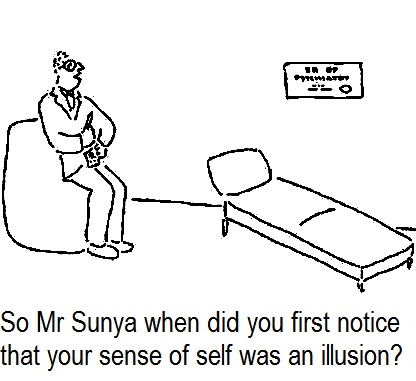 This weekend I joined my fellow Shambhala Buddhists for our regular book club. Every 4 to 6 weeks, we take a book which has a Buddhist tone: its not always a Dharma book – as we often take more mainstream psychology books (as I have written about previously) or even novels. I enjoyed our latest selection, Robert Wright’s book “Why Buddhism is true”, as it blends the very latest in neuroscience and psychology, and relates these to descriptions of meditation found in the original Buddhist texts.
This weekend I joined my fellow Shambhala Buddhists for our regular book club. Every 4 to 6 weeks, we take a book which has a Buddhist tone: its not always a Dharma book – as we often take more mainstream psychology books (as I have written about previously) or even novels. I enjoyed our latest selection, Robert Wright’s book “Why Buddhism is true”, as it blends the very latest in neuroscience and psychology, and relates these to descriptions of meditation found in the original Buddhist texts.
I became a practicing Buddhist during this “the mindfulness revolution”, so I have not known a time when meditation and its effects wasn’t being researched by scientists. Although I come from a background in the natural scientists, I haven’t needed the reports from peer-reviewed journals to tell me that meditation works (or as Wright says why Buddhism is “true”). What I have appreciated about Buddhism and its practices is its empiricism: I am not asked by the Buddhist texts to believe a theory or rely on logic, but rather to observe my experience directly. I do this on the cushion as I meditate, and I (try to!) to do this in everyday life and when I am in the therapy room with my clients.
I value so much about the “mindfulness revolution”. As a teacher of courses such as Mindfulness Based Stress Reduction and Mindfulness Based Cognitive Therapy, I have helped many people discover the practice of meditation and its benefits. Simply sitting and observing the breath allows our nervous system to settle a little: we feel calmer (once we get over the tendency to judge our meditation performance as “good or bad”) and because we are calmer we find it a little easier to be kinder and more compassionate people. Simply sitting for 15 to 20 minutes a day is a practice I recommend to anyone, and many of my therapy clients now meditate to find some space and release from their distress.
So, when a book like Robert Wright’s comes along, I appreciate the attempts to explain why such a practice is good for us. I particularly like how he gets across we are hard-wired for survival not happiness; and when we sit to meditate much of our experience is governed by this. Take what neuroscientists are discovering regarding the “default mode network” – a large scale brain network of interacting brain regions that set up self-related thinking. In an attempt to shore up our personal identity, mind activity flits from past to future seeking consistency, creating a thread through our stories: its the reason we feel a “me” has existed over time. This is useful when it comes to our survival and passing on our genes. But, its not so helpful when we are trying to stay in the present and be content resting with the breath. Wright also describes an idea within the field of evolutionary psychology, that of the “modular” mind: the mind as being composed of lots of specialised modules and these modules shape our behaviour. There might be a module for “finding a mate”, a module for “keeping my mate”, “being successful” (so I attract a mate), “staying alive” (so I get to reproduce with my mate)…you probably get the picture. I think Wright beautifully explains how we can be meditating, and within the torrent of thoughts we might detect a certain texture – perhaps a series of thoughts that could be labelled “planning”, because our module for “staying safe” might be shouting the loudest at our consciousness, invading and hijacking our experience.
My intention of this post isn’t so much to applaud or review Wright’s book (I might leave that to another time!) but rather to get across the second reason why I enjoy books like this: it reminds me as to why I am a Buddhist and not simply someone who meditates. There is a critique of the mindfulness revolution that I tend to subscribe to: that mindfulness could do with getting plugged back in to its Buddhist roots. When reading Wright’s book these past few weeks, much of what he was describing reminded me of a podcast I listened to back in the Spring of last year – one in which ABC anchorman, Dan Harris interviews neuroscientist and philosopher Sam Harris (no relation). In their discussion, they talk about a differentiation of first-order vs second-order mindfulness.
Short interlude for some definitions:

First-order change occurs on the behavioural level without impacting the operating rules of the system. These changes are considered moresuperficial and less sustainable than second-order changes. For example, take a couple that fight all the time. To stop the fighting, they decide to just stop talking altogether. This “works” because they no longer fight but they have not changed the underlying dynamic, or “rule,” of hostility that governs their relationship.

Second-order change involves not just behaviour, but changes or “violates” the rules of the system itself. In the example of our couple, next time they fight one of them gestures a “time-out” and asks “what might I have done differently so not to upset you?”. This breaks the rule of hostility (at least temporarily) and disrupted this habitual negative dynamic of fighting. The hostility that is at the root of their fighting is itself interrupted. First-order changes are considered less sustainable and less impactful than second-order changes
First-order mindfulness is what people on MBSR or MBCT courses learn – to take an “object” (like the breath, or the body) and practice bringing the attention to the breath (I say “bringing”, as most of the time this is what we are doing, bringing the mind back to the breath rather than staying with it all the time). This type of practice begins a useful separation of subject (“I”) and object (“the breath”); an ability that trickles through to less attachment to our thinking. How come this is first-order? Well, whilst change DOES come from this type of meditation, its the kind of change that doesn’t stick unless we keep doing the practice. What is really needed is a change in view too…
Second-order mindfulness drops the subject and object all together – so rather than “I am watching the breath” there is a non-dual awareness of “breathing”. Lets consider how this comes about. In a meditation where the object is the breath, we train our mind towards the feeling of the breath in and out; with time we notice that we are thinking and no longer with the breath, so we “come back”, and this can be time and time again. With extended time periods, we might notice our mind is slowing down – a bit like a muddy jar would separate out in to the dirt settling at the bottom, and the clear water. Clarity that helps us see thoughts come and thoughts go, an experience of “thinking”, knowing we are thinking, knowing we are breathing. So with first order mindfulness, we develop a watcher; in second-order mindfulness we simply experience without any need for self-reference, or a “me”. Dan and Sam Harris discuss how the Buddhist view helps by providing a frame and a series of practices to undo the habit of creating a self in each moment. Advanced practitioners will know this as Dzogchen or Mahamudra – teachings that helps us see the “is-ness” of experience rather than the labels and stories we so often apply on top.
Why is this important? It allows us to experience the illusion of the self. This doesn’t mean (as is often confused) that we don’t exist, but rather that we don’t exist in the way we think we do. And this is useful, as without a “me” to defend, we can be more open to our world and to others. I see this playing out in my work with clients who bring relational issues. The experience of pain gets turned in to a story about blame whenever we create an expectation on the other – “they are my husband, they shouldn’t do that to me”. How can we drop the “they”, the “me”, the story that this always happens but shouldn’t?
And I believe this is where Buddhist thought and practice can be an ally to the work of psychotherapy. By becoming more familiar with the mental activity, learning how to see the habitual patterns of mind and realise these thoughts are not who we are we develop a benevolent space – something akin to what Donald Winnicott called the “holding environment”. Just like the benevolent caregiver, we can offer ourselves a space for difficult emotions to come up. As Mark Epstein suggests in his latest book, a weaving together of therapy and meditation is not about eradicating a personal history but rather therapy brings understanding to the personal, and a Buddhist view allows us to hold it with wisdom and compassion. Bringing together both can reveal “how to live fully”
I’d love to hear what you think of these writings and podcast, and how this might be useful to you in your life.
